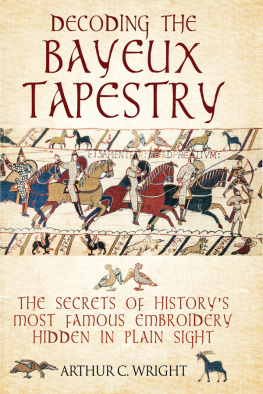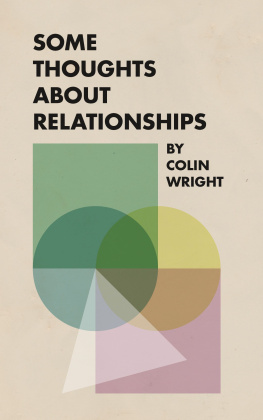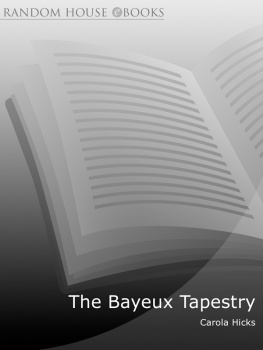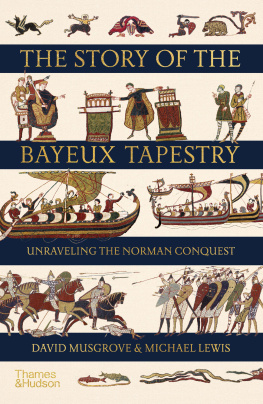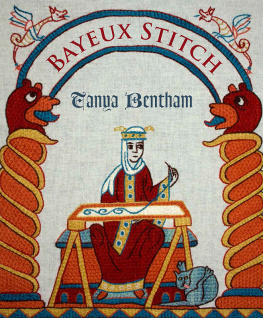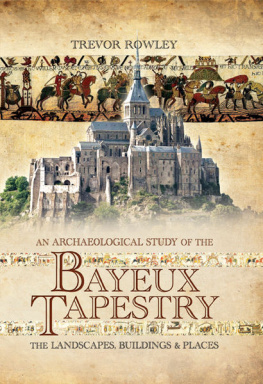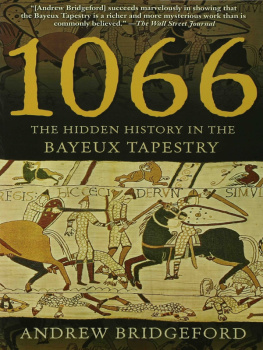Arthur Colin Wright - Decoding the Bayeux Tapestry
Here you can read online Arthur Colin Wright - Decoding the Bayeux Tapestry full text of the book (entire story) in english for free. Download pdf and epub, get meaning, cover and reviews about this ebook. year: 2019, publisher: Frontline Books, genre: Religion. Description of the work, (preface) as well as reviews are available. Best literature library LitArk.com created for fans of good reading and offers a wide selection of genres:
Romance novel
Science fiction
Adventure
Detective
Science
History
Home and family
Prose
Art
Politics
Computer
Non-fiction
Religion
Business
Children
Humor
Choose a favorite category and find really read worthwhile books. Enjoy immersion in the world of imagination, feel the emotions of the characters or learn something new for yourself, make an fascinating discovery.
- Book:Decoding the Bayeux Tapestry
- Author:
- Publisher:Frontline Books
- Genre:
- Year:2019
- Rating:5 / 5
- Favourites:Add to favourites
- Your mark:
- 100
- 1
- 2
- 3
- 4
- 5
Decoding the Bayeux Tapestry: summary, description and annotation
We offer to read an annotation, description, summary or preface (depends on what the author of the book "Decoding the Bayeux Tapestry" wrote himself). If you haven't found the necessary information about the book — write in the comments, we will try to find it.
Decoding the Bayeux Tapestry — read online for free the complete book (whole text) full work
Below is the text of the book, divided by pages. System saving the place of the last page read, allows you to conveniently read the book "Decoding the Bayeux Tapestry" online for free, without having to search again every time where you left off. Put a bookmark, and you can go to the page where you finished reading at any time.
Font size:
Interval:
Bookmark:

DECODING THE
BAYEUX TAPESTRY
THE SECRETS OF HISTORYS MOST FAMOUS EMBROIDERY HIDDEN IN PLAIN SIGHT
ARTHUR WRIGHT


DECODING THE BAYEUX TAPESTRY
The Secrets of Historys Most Famous Embroidery Hidden in Plain Sight
First published in Great Britain in 2019 by
Frontline Books
An imprint of
Pen & Sword Books Ltd
Yorkshire - Philadelphia
Copyright Arthur Wright
ISBN 978 1 52674 110 3
eISBN 978 1 52674 111 0
Mobi ISBN 978 1 52674 112 7
The right of Arthur Wright to be identified as the author of this work has been asserted by him in accordance with the Copyright, Designs and Patents Act 1988.
A CIP catalogue record for this book is available from the British Library
All rights reserved. No part of this book may be reproduced or transmitted in any form or by any means, electronic or mechanical including photocopying, recording or by any information storage and retrieval system, without permission from the Publisher in writing.
Pen & Sword Books Ltd incorporates the Imprints of Aviation, Atlas, Family History, Fiction, Maritime, Military, Discovery, Politics, History, Archaeology, Select, Wharncliffe Local History, Wharncliffe True Crime, Military Classics, Wharncliffe Transport, Leo Cooper, The Praetorian Press, Remember When, Seaforth Publishing and Frontline Publishing.
For a complete list of Pen & Sword titles please contact
PEN & SWORD BOOKS LTD
47 Church Street, Barnsley, South Yorkshire, S70 2AS, England
E-mail:
Website: www.pen-and-sword.co.uk
Or
PEN AND SWORD BOOKS
1950 Lawrence Rd, Havertown, PA 19083, USA
E-mail:
Website: www.penandswordbooks.com
A lthough it is difficult to obtain an exact economic value to the town of Bayeux today, 400,000 visitors each year pass through the Muse de la Tapisserie de Bayeux, established in 1949. Something like 400 books and articles have been written about this embroidery 224 feet long composed of eight bands of linen sewn into one continuous strip. It shows something like 632 human figures, 560 animals and a further 202 horses with forty-one ships and thirty-seven buildings and it is 950 years old. It is an incredible object and an amazing survivor and, until 1476, no one even knew it existed. Only in the early nineteenth century was it really recognised and from then onwards it has fascinated scholars and visitors, writers and readers, teachers and children by the millions in England and in France and right around the world. It is a national treasure, but whose national treasure is it really and, in spite of so many volumes (which do not always agree), who can be certain what it actually tells us? Who, indeed, has actually read what all the words and all the pictures say?
The accounts we have of the events of 1066 were written by the victors (it is always so) and so the analyses presented by them and by their followers often display personal and political motivations. Accounts written not long after the event, for political reasons, though commonly employed as history, I call the panegyrists, toadies, authors seeking to flatter William and to justify the Norman occupation of England. They were the beneficiaries of the Conquest and, looking for further rewards, what else could they write but stories that conformed to the desires of the conquerors?
These histories of the Conquest do not always agree with one another, but they do all agree that the Conquest was a good thing. Well, was it?
We all recognise that it is dangerous to listen to and then espouse one side in a dispute and not the other. Despite this, I am going to refer to the Bayeux Tapestry throughout as the Tapestry, even though it isnt a tapestry at all but an embroidery. Come to that, it was only found at Bayeux, it wasnt made there and might not even belong there. What is more, the Battle of Hastings wasnt fought at Hastings either. It seems that our histories arent very logical.
To me the past is not just a kaleidoscope, neither should it be a false image, a door banged shut. Our embroidery, the Tapestry, is a veil to be lifted.
Others have pieced together the dynastic and chronological aspects of the main story shown on this embroidery, the main tableau. These scholars tell us both the broad and the detailed picture of events into which this visual record has to be set in order to comprehend its significance. What concerns me is the imperfect picture we have of the Norman invasion and Conquest on the English side, for though the Normans have left us a vast amount of material, or so it seems, it is difficult to construct the opposite side of the picture, the English story. I hope that I can correct this evidence, redress the balance and discover a fuller picture of the invasion. In fact, when we have all the evidence at our finger-tips we will be better able to evaluate what has been said before because what has been said before has always omitted a key part of the evidence. We might declare that everything said so far has only ever been based on two-thirds of the embroidery. Now we will read it all.
To some people medieval history is a fantasy world, like the Game of Thrones. Well, our Tapestry has margins that fit this view very well. They are peopled with bright, imaginatively coloured birds and animals who call to one another, converse, play, cover their faces with their wings, bite their own tails, fall over backwards in excitement. Gryphons, fire-breathing dragons, half-dragons, ravens, vultures, eagles, lots of big cats of all colours, goats, bears, lions, camels, centaurs and other things besides are there, filling the space top and bottom until we come to the battle. Here there is all the violence and butchery you can desire.
We all accept that the people who designed our cars knew about engines, suspension and steering, otherwise who would race off at 60 miles an hour in one? But academics tell their students the pleasure of history is that opinions are always changing, new theories floated. Unlike science there are no inconvenient facts.
My interest in the Tapestry lies principally in what we can lump together at the margins, the top and bottom borders that follow the main story, schema or presentation. I hope they may contain some clues otherwise overlooked. Pictures also communicate, sometimes much better than words. Indeed, it is often quoted as an educational axiom that one picture is worth a thousand words. So, my aim is to explain these, heretofore, generally ignored and uncomprehended, subordinate (pictorial) details.
I do not subscribe to the argument that these margins are largely mere decorative elements. Neither do I accept them as being esoteric and intellectual exercises in the methodology of interpreting religious texts according to the accepted rules (called biblical hermeneutics) done for the amusement of a few (and of course, even then exceptional) superior monkish scholars. The Tapestrys audience was secular rather than religious and it certainly was not academic. I hope to demonstrate that these margins play an important part in both the schema and the story it presents at an everyday level and that they consequently add to the picture we are able to reconstruct from this important period in our history. They help us solidify the knowledge gained from the schema. That they also open up a new window on the ability of our ancestors, who were very different to us in their thoughts and culture, to communicate, is a further bonus.
Font size:
Interval:
Bookmark:
Similar books «Decoding the Bayeux Tapestry»
Look at similar books to Decoding the Bayeux Tapestry. We have selected literature similar in name and meaning in the hope of providing readers with more options to find new, interesting, not yet read works.
Discussion, reviews of the book Decoding the Bayeux Tapestry and just readers' own opinions. Leave your comments, write what you think about the work, its meaning or the main characters. Specify what exactly you liked and what you didn't like, and why you think so.

